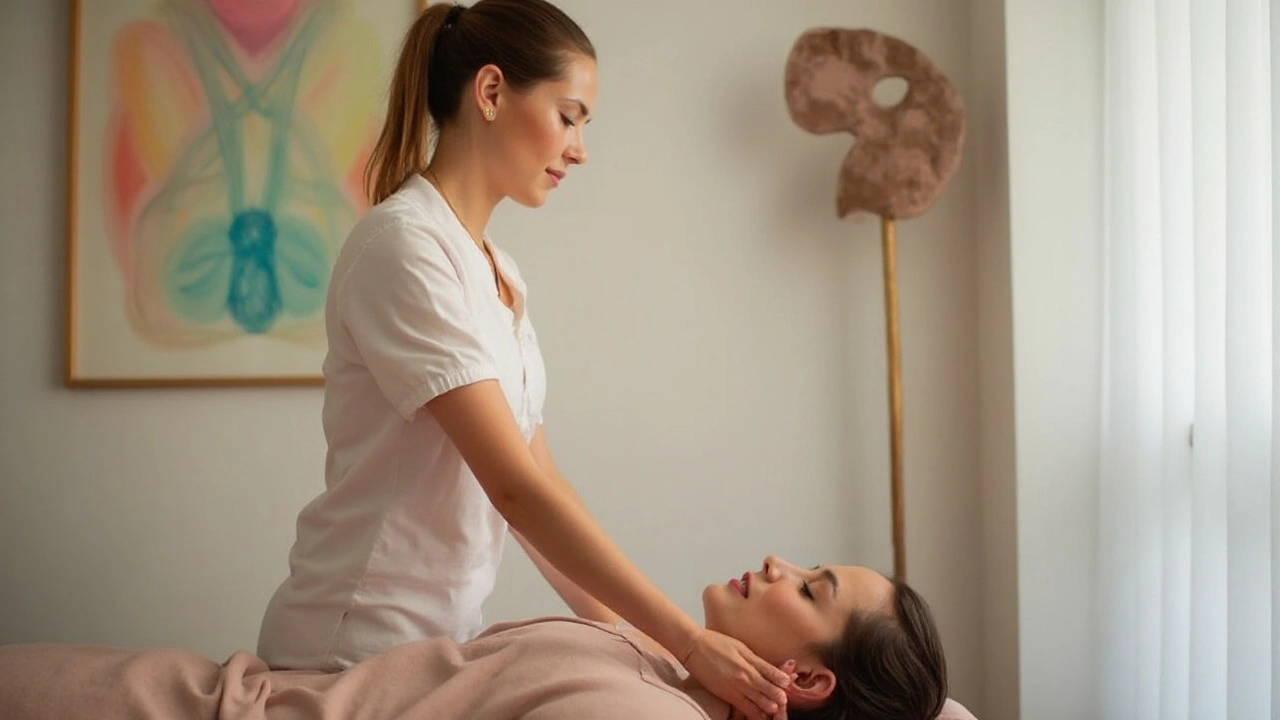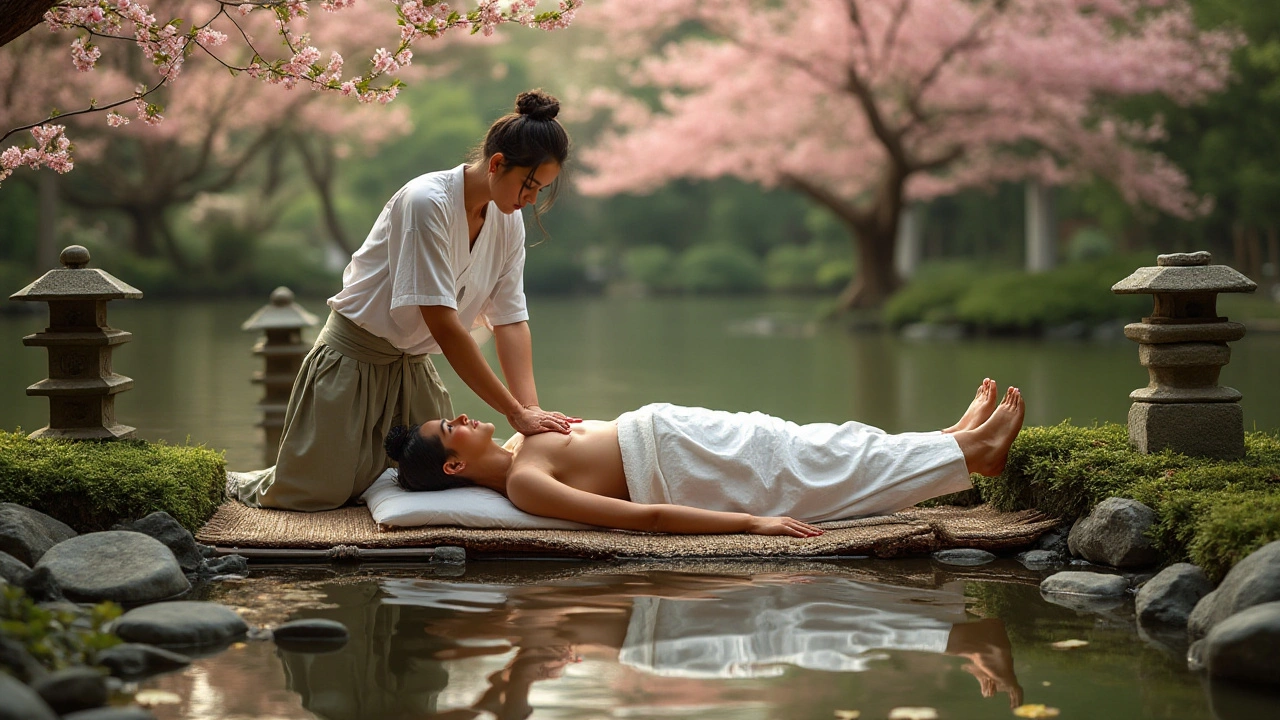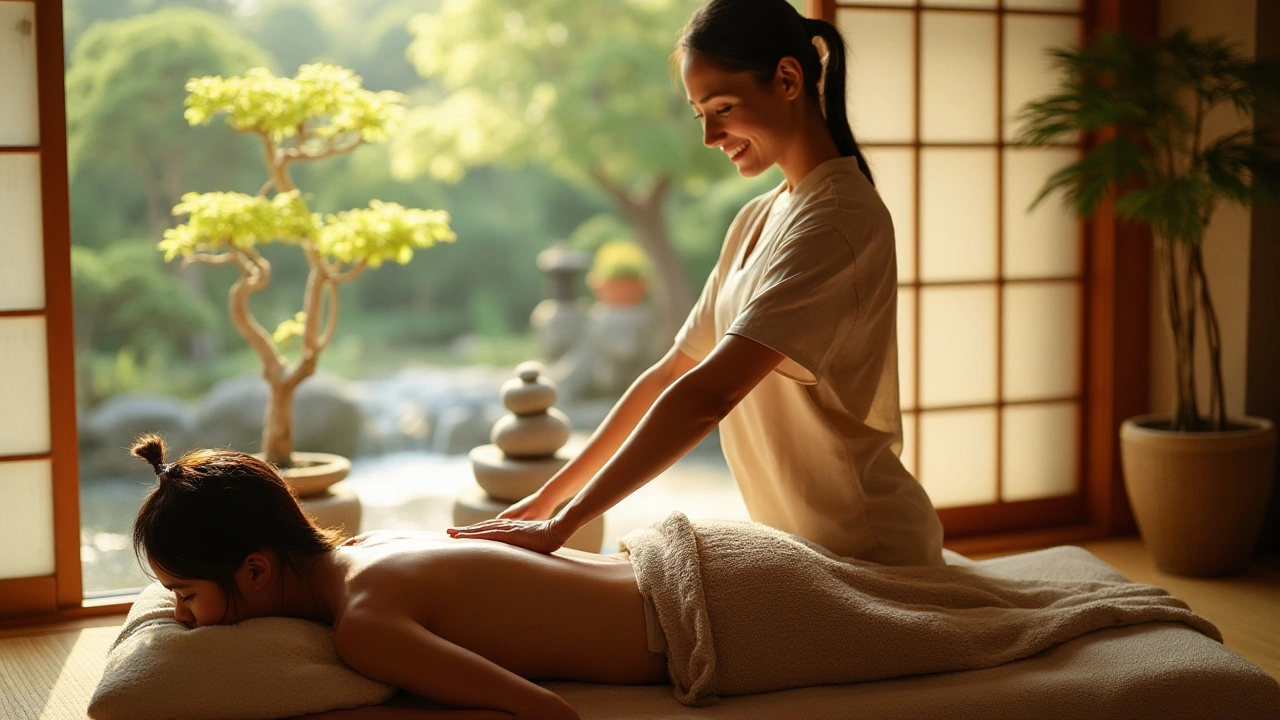Shiatsu massage is steadily gaining attention across the globe, not just as a form of body relaxation, but as a complete wellness approach. With roots deeply planted in Japanese tradition, this technique is more than just a massage; it is a way to balance the body's natural energy.
Practitioners utilize hands, thumbs, elbows, and even knees to apply pressure along the body's energy pathways, or meridians. The idea is to promote and sustain health by encouraging the natural flow of energy.
Many who experience Shiatsu are surprised by the depth of its influence, noticing not only a decrease in physical discomfort but also an enhancement in mental clarity and emotional balance. Shiatsu is thus much more than a massage; it's part of a growing trend towards holistic health practices that integrate mind, body, and soul.
- Understanding Shiatsu Massage
- Benefits of Shiatsu Massage
- Techniques Used in Shiatsu
- Incorporating Shiatsu into Your Routine
Understanding Shiatsu Massage
Shiatsu massage traces its origins back to Japan, an art form refined over centuries, evolving from ancient Eastern influences into a practice that has captivated the West. This technique spans the line between science and tradition, founded on the belief that optimal health depends on the free flow of vital energy, or 'Qi', within our bodies. Central to Shiatsu's philosophy is the network of meridians, a concept borrowed from traditional Chinese medicine. These invisible channels carry energy throughout the body, linking crucial organs and systems in a flow that practitioners aim to harmonize.
The term "Shiatsu" translates directly to "finger pressure"; however, it involves more than just percussive touch. Everyday routines among practitioners can include kneading, soothing, tapping, and stretching techniques. Unlike Western massage approaches that often fixate on muscle groups and structures, Shiatsu principles concentrate on holistic body wellness. Channels of energy are pressed and manipulated using not only fingers and thumbs but sometimes palms, knees, and elbows as well.
A key aspect of its practice is enhancing body awareness – both for the practitioner and the client. This self-awareness isn't just about recognizing a sore back or a knot in a muscle but becoming attuned to lesser-known signals your body might be sending. It often encourages people to think about their lifestyle choices and emotional health in conjunction with physical treatment. With its relaxing and integrative nature, people have found Shiatsu helpful for stress, digestive disorders, and even fibromyalgia.
Shiatsu massage sessions often resemble a dance of rhythm and intuition between the practitioner and client, creating a tailored experience. Treatment usually occurs on a padded floor mat, allowing for the free movement of both parties. The process often doesn’t use oils, adhering to its minimalist roots, making it a unique experience compared to traditional Western massages. The natural skin contact supposedly channels warmth and Qi more effectively.
Shiatsu's global rise in popularity can be credited to both its historical roots and modern influences. There's something inherently appealing about the blend of old-world wisdom with contemporary wellness expectations. As a Japanese government-sanctioned form of therapy, Shiatsu has been recognized as a legitimate therapeutic practice, different from today's spa-centric caricature.
"Shiatsu is not just a technique, it is a philosophy that taps into the universal law of balance," explains Dr. Shigeru Onoda, a renowned expert in the art.
The appeal of Shiatsu massage comes from this fascinating confluence of practical benefit and meditative balance. Many practitioners stress the massage's ability to ground its recipients, offering not just physical alignment but emotional and psychological harmony as well. Its practice encourages people to resort to non-invasive treatments while unraveling the complexities of mind-body connections in the human experience.

Benefits of Shiatsu Massage
The ancient art of Shiatsu massage offers a plethora of benefits that go beyond the surface, delving into both physical and emotional realms. At its core, Shiatsu focuses on enhancing the body's natural energy flow, which, when balanced, can lead to profound health improvements. This technique works diligently to relieve muscle tension, often attributed to common stressors in our modern lives. Regular sessions can lead to noticeable reductions in knots and tension aches, allowing individuals to carry out daily tasks with greater ease and comfort.
People often report a significant rise in mood and mental well-being post Shiatsu. This practice is known for its ability to ease anxiety and boost overall mental clarity. By applying varying pressure to certain points along the meridian lines, Shiatsu can effectively prompt the brain to release endorphins, often dubbed as the 'feel-good' hormones. A deep sense of relaxation naturally follows, which can be quite rejuvenating. In some instances, therapists attribute improved sleep patterns to these sessions, helping those grappling with insomnia find their restful nights once again.
Physical Health Benefits
From a physical health perspective, Shiatsu boasts capabilities that bolster the circulatory and immune systems. As pressure is applied to the skin and underlying muscles, blood flow can be stimulated, promoting the oxygenation of tissues and aiding metabolism. This enhanced circulation translates to a better functioning immune system, prepared to ward off seasonal colds and infections. Additionally, Shiatsu supports lymphatic drainage, further detoxifying the body.
In a study published in a well-regarded journal, participants who received regular Shiatsu treatments reported a decrease in various types of chronic pains, especially those stemming from arthritis and fibromyalgia. This traditional method often complements modern medical approaches, providing a holistic pathway to relief.
"Shiatsu empowers the body to heal itself in ways modern medicine often doesn't acknowledge," notes Dr. Yuki Tanaka, a leading voice in complementary therapies.
The ripple effects of this ancient Japanese technique are tangible, with practitioners noticing benefits in digestion and even reproductive health. Thanks to its gentle yet effective nature, Shiatsu has become a favorite for many seeking a natural approach to restore their well-being. Those who integrate Shiatsu into their wellness routines often find themselves with an energizing sense of balance, echoed in both their movements and outlook on life.

Techniques Used in Shiatsu
Shiatsu massage is much more than kneading and rubbing; it’s a symphony of movements designed to harmonize the body's energy, known as 'ki'. This ancient Japanese technique employs a variety of unique and precise movements that can be as gentle as a feather or as firm as needed. One of the foundational techniques used in Shiatsu is the application of rhythmic pressure to the body's meridians. These are considered pathways that channel the body’s life energy. The practitioner uses their thumbs, fingers, palms, and sometimes elbows or knees to deliver pressure along these pathways. This approach is believed to restore and balance energy flow, promoting both physical and mental wellness.
The art of Shiatsu heavily relies on the knowledge of body anatomy mixed with an understanding of how energy flows within. Practitioners often start with a gentle palm press to sense areas of tension or imbalance. This diagnostic touch is referred to as 'Namikoshi', named after Tokujiro Namikoshi who standardized modern Shiatsu over 100 years ago. The focus then shifts to specific pressure points known as 'Tsubo', which correlate with the body's organs and functions. Stimulation of these points is meant to support self-healing mechanisms, enhance circulation, and relieve stress. A balance between pressing and stretching forms the core of Shiatsu techniques, making it a holistic remedy.
Interestingly, Shiatsu incorporates the principle of Zen, which involves meditative silence during treatment. This quiet allows both the giver and receiver to connect more deeply, enhancing the overall therapeutic effect.
According to a statement by Shizuto Masunaga, a renowned figure in the field, "Shiatsu is like the mother holding the child. That warmth, that pressure, it conveys love without words." This focus on connection through touch has made Shiatsu a much sought after therapy for those seeking more than just physical relaxation.Techniques in Shiatsu are not standardized universally, as practitioners personalize their method to suit individual needs. Some might integrate rocking motions to enhance relaxation, while others may use point-specific pressure. Each session is a tailored experience, focusing on the unique energy flow of the individual, which makes Shiatsu not just a treatment, but an art form.
A growing body of research supports the benefits of Shiatsu techniques, with studies showing improvements in mood and reductions in anxiety. A survey conducted in 2022 indicated that 85% of Shiatsu recipients reported feeling more calm and focused after their sessions. This data shows just how impactful these methods can be in enhancing quality of life. Whether to alleviate pain, increase flexibility, or simply promote well-being, the techniques used in Shiatsu offer a comprehensive approach that addresses various health aspects, proving its enduring appeal in today's wellness circles.

Incorporating Shiatsu into Your Routine
Integrating Shiatsu massage into your daily or weekly wellness routine might seem daunting at first, but it is a decision that many find rewarding for both body and mind. This ancient Japanese practice is not just for the occasional visit to a therapist; it's something you can incorporate into your home routine. To start, consider learning some basic techniques or watch online tutorials that demonstrate how to apply pressure correctly on your body's meridians. This practice can be self-administered or shared with a partner, making it a flexible option for home wellness.
Some may find it particularly beneficial to schedule a regular session with a certified Shiatsu therapist. Doing so can help tailor the massage to your specific health needs, whether they are physical, emotional, or both. Regular sessions can help maintain energy balance and prevent stress from building up. Many experts believe that consistency is key when it comes to the benefits offered by Shiatsu. As the well-known practitioner Masunaga stated,
“Shiatsu is like a mother’s warm hand on a child’s fevered forehead.”This quote emphasizes the comforting and healing nature of the technique, making its integration into everyday life invaluable.
If you’re managing a busy schedule, try incorporating shorter sessions into your daily routine. Even a 10-minute practice each day can significantly reduce stress and improve your body wellness. Begin with a focus on breathing and gentle pressure points, perhaps in the morning or right before bed. Many people find it helpful to pair Shiatsu with other relaxation techniques such as meditation or yoga. Any form of self-care practice will complement Shiatsu's focus on balancing life-energy or 'Qi' as it's traditionally called.
Considering the societal lean towards remote work, home-based Shiatsu sessions are becoming especially popular. Creating a dedicated space for this practice in your home can enhance the experience. Use a comfortable mat and ensure a peaceful ambiance, possibly with calming music or incense. These carefully curated environments can enrich sessions, making them a cherished part of your day.
Additionally, look into apps that offer guidance for self-massage techniques and a library of resources about relaxation techniques. Whether you're dealing with muscular tension or just aiming for a more balanced lifestyle, these digital tools can be a great supplement to your practice. Remember, the goal of Shiatsu is not to replace professional medical care but to serve as a complement, offering a holistic approach to wellness.
With time and consistency, Shiatsu can transform from a once-in-a-while indulgence to an essential part of your health routine. Whether your aim is to alleviate stress, improve blood circulation, or simply enjoy a moment of peace in your day, embracing Shiatsu could be the lifestyle shift your body and mind have been seeking.


 Health and Wellness
Health and Wellness